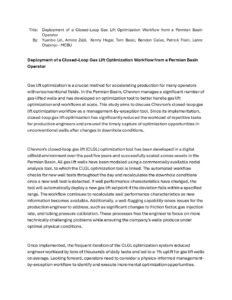Deployment of a Closed-Loop Gas Lift Optimization Workflow from a Permian Basin Operator
by Authors:
Yuanbo Lin – Chevron USA
Patrick Frain – Chevron USA
Abstract
Gas lift optimization is a crucial method for accelerating production for many operators with unconventional fields. In the Permian Basin, Chevron manages a significant number of gas-lifted wells and has developed an optimization tool to better handle gas lift optimization and workflows at scale. This study aims to discuss Chevron’s closed-loop gas lift optimization workflow as a management-by-exception tool. Since its implementation, closed-loop gas lift optimization has significantly reduced the workload of repetitive tasks for production engineers and ensured the timely capture of optimization opportunities in unconventional wells after changes in downhole conditions.
Chevron’s closed-loop gas lift (CLGL) optimization tool has been developed in a digital oilfield environment over the past five years and successfully scaled across assets in the Permian Basin. All gas lift wells have been modeled using a commercially available nodal analysis tool, to which the CLGL optimization tool is linked. The automated workflow checks for new well tests throughout the day and recalculates the downhole conditions once a new well test is detected. If well performance characteristics have changed, the tool will automatically deploy a new gas lift setpoint if the deviation falls within a specified range. The workflow continues to recalculate well performance characteristics as new information becomes available. Additionally, a well-flagging capability raises issues for the production engineer to address, such as significant changes to friction factor, gas injection rate, and tubing pressure calibration. These processes free the engineer to focus on more technically challenging problems while ensuring the company’s wells produce under optimal physical conditions.
Once implemented, the frequent iteration of the CLGL optimization system reduced engineer workload by tens of thousands of daily tasks and led to a 1% uplift for gas lift wells on average. Looking forward, operators need to consider a physics-informed managementby-exception workflow to identify and execute incremental optimization opportunities.

